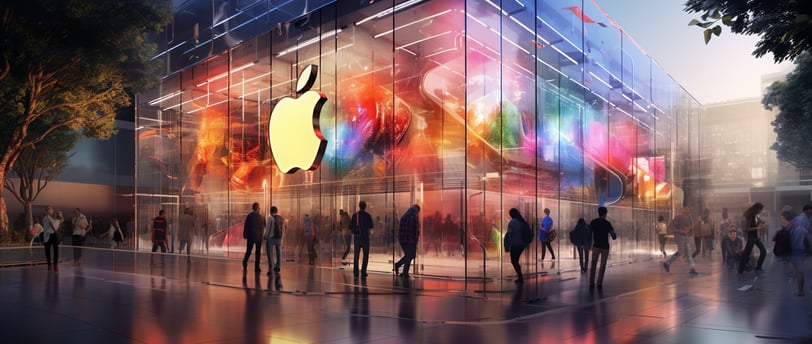Apple's Innovation in Design: A Journey of Elegance, Functionality, and Life Lessons
Explore the innovation and elegance behind Apple's design philosophy in this enlightening blog post. From the minimalism of early products to the courage in creativity and commitment to sustainability, uncover the profound lessons that Apple's design journey offers. Learn how these principles can be applied in business, work, and daily life, transforming challenges into opportunities and nurturing a spirit of excellence and creativity.
8/13/20233 min read


Introduction
Apple Inc. has become synonymous with design innovation, setting a precedent that transcends the boundaries of gadgets and technology. This post delves deep into the journey of Apple's design, exploring key products and the underlying philosophy that has shaped the industry, and uncovering profound lessons that can be applied in business, work, and daily life.
1. The Early Days: Minimalism and Simplicity
- Apple I & II: The birth of a design era with the creation of the Apple I & II, focusing on clean and straightforward design, a pioneering step away from the cluttered and complex computer designs of the time.
- Macintosh: A watershed moment with the introduction of Macintosh, a pioneer in user-friendly interfaces, setting a new and accessible standard for personal computing.
- Lesson in Simplicity: Embracing a philosophy of stripping away complexity to focus on what truly matters, a principle that can be applied in everything from business strategies to daily life, fostering clarity and purpose.
2. The Jonathan Ive Era: A Renaissance in Design
- iMac: A bold and innovative design with the iMac, bringing a refreshing new aesthetic to computing, showcasing transparent materials and vibrant colors that invigorated the market.
- iPod: A monumental shift in music consumption with the iPod, turning technology into fashion, transforming how we engage with music, and making it a personal and stylish experience.
- iPhone: More than just a phone, the iPhone's groundbreaking design made it an icon of the modern era, changing the way we communicate, connect, and consume content.
- Lesson in Courage and Creativity: The importance of challenging the norm and being creatively courageous in business and personal pursuits, encouraging innovation, risk-taking, and breaking free from conventional thinking.
3. The Power of Integration: Software Meets Hardware
- iOS and Mac OS X: Creating a cohesive and seamless user experience through the integration of iOS and Mac OS X, fostering harmony between software and hardware, enhancing user engagement and satisfaction.
- Lesson in Integration and Cohesiveness: In business, work, or personal life, integration and alignment of goals create harmony and efficiency, promoting shared visions, and interconnected growth.
4. Environmental Consideration: Sustainable Design
- Recycled Materials and Energy Efficiency: Demonstrating a commitment to sustainability in product design through recycled materials and energy-efficient processes, aligning innovation with environmental responsibility.
- Lesson in Responsibility: Recognizing that sustainability is not merely a trend but a shared global responsibility, applicable in every aspect of life, driving mindful choices, and long-term thinking.
5. The Future of Apple Design: Continual Innovation
- M1 Chip, Augmented Reality, and VR: Embracing the future with cutting-edge technologies like the M1 chip, augmented reality, and VR, continually pushing boundaries, and redefining possibilities.
- Lesson in Forward Thinking: Always looking ahead and embracing change, whether in career planning, business development, or personal growth, fostering adaptability, resilience, and a pioneering spirit.
6. Design Philosophy: Form Meets Function
- User-Centric Approach: Centering design around the user's experience, empathizing with needs, and crafting solutions that resonate with users, building loyalty and satisfaction.
- Attention to Detail: Pursuing meticulous crafting in every aspect of product design, from aesthetics to functionality, showcasing excellence, quality, and precision.
- Lesson in Empathy and Excellence: Developing a keen understanding of others' needs and striving for excellence in all endeavors, guiding success in any field, nurturing relationships, and creating value.
7. Collaboration and Teamwork in Design
- Cross-Functional Teams: Building synergy through cross-functional teams, melding different talents and perspectives, leading to innovative and holistic solutions, fostering creativity, and harmony.
- Lesson in Collaboration: Emphasizing the power of working together, valuing diverse perspectives, and nurturing a culture of cooperation and mutual respect, whether in a corporate environment or family life.
8. The Aesthetics of Everyday Life
- Apple Stores, Packaging, and Accessories: Elevating everyday objects like stores, packaging, and accessories into works of art, transforming mundane experiences into memorable interactions, reflecting quality, and elegance.
- Lesson in Beauty and Mindfulness: Cultivating an appreciation for beauty in everyday life, being mindful of surroundings, and embracing the aesthetic experience, enriching daily life, and promoting well-being.
Conclusion
Apple's design innovation is a rich tapestry of elegance, functionality, and transformative life lessons. From the early days of minimalism to the future of continuous innovation, Apple's legacy resonates as a universal guide to excellence, creativity, and responsible growth. By embracing these lessons, we can navigate our personal and professional journeys with wisdom, courage, and creativity, transforming challenges into opportunities and dreams into tangible realities.
